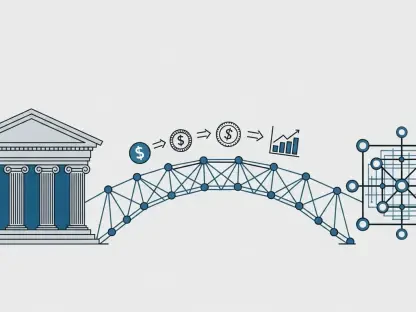Hyper-automation means using new technologies like artificial intelligence (AI), machine learning, robotic process automation, and many other new tools to automate whole business processes, instead of using them to transform single tasks. It goes further than basic automation by connecting different systems, processes, and technologies to create a better workflow. To sum up, hyper-automation aims to automate everything that it can within a company. In the financial technology world or fintech, hyper-automation can be used to alter businesses, boost profits and even reshape companies everywhere.
Hyper-automation has a wide variety of uses and benefits, from enhancing customer experience to lowering costs. According to Emergen Research, companies like Tata Consultancy Services, UiPath and Automation Anywhere Inc. have already made considerable profits by providing others with hyper-automation tools, and the global size of this market is expected to grow even more, peaking at USD 22.84 billion by 2027. Hyper-automation is undoubtedly on the rise in fintech, as more and more companies are now adopting this solution to enhance customer experience, improve risk management, lower costs and more. Moreover, the benefits of adopting hyper-automation are multi-layered.
Using hyper-automation to enhance customer experience
Hyper-automation can make an impact on customer experience. AI-powered chatbots and virtual assistants can answer customer questions right away, all day and night, boosting customer support. These bots can constantly improve by learning from earlier conversations to give better answers. Hyper-automation can also streamline Know Your Customer (KYC) processes and tools. These procedures include, but are not limited to checking identities, collecting data, and ensuring legal compliance while also lowering the percentage of human mistakes.
Using hyper-automation to boost risk management
As numerous insurance companies already know, hyper-automation has an impact on detecting odd patterns that might point to fraud or cyber threats. It does this by looking at huge amounts of transaction data as it happens, prompting companies to act fast and lower risks. Hyper-automation can also predict financial risks, and how customers will act in a foreseeable scenario. It does this by using deep data analysis, which can help companies make better choices when it comes to risk management.
Using hyper-automation to simplify different work processes
Hyper-automation allows fintech companies to automate different activities that involve risks, for instance, loan approvals, underwriting, or investment portfolio management. This can increase the rate of undertaking activities and lower the overall costs. Moreover, hyper-automation also includes Robotic Process Automation or RPA. Typical RPA jobs now include typing, data inputting, consolidation, and verifying compliance, which enables human employees to focus on functional responsibilities. This can increase the efficiency of their workers while reducing the time they spend on repetitive tasks.
Using hyper-automation to ensure legal compliance
Fintech is one of the many industries where compliance rules are most stringent, thus it can be a rather painful process to conquer. Hyper-automation can assist fintech organizations to identify and rework various processes to avoid non-compliance, while generating correct reports to ensure legal compliance. Moreover, hyper-automation can also be used to improve audit trails and transparency. Record, log and audit trail systems can be fully automated to meet regulatory, as well as internal requirements.
Using hyper-automation to reduce costs
Boosting a company’s performance is never easy, but the good news is that fintech organizations can use hyper-automation to reduce costs too. According to Leapwork, hyper-automation reduces costs by automating repetitive work in multiple departments simultaneously, prompting faster and more durable work. This, in turn, boosts performance and productivity, and it also lowers labor costs, as well as overall expenses. To sum up, one of the main advantages of using hyper-automation in fintech is the fact this new technology can be used to make cutbacks.
Using hyper-automation to gather data
Hyper-automation means that there is constant supervision of the financial activities undertaken by the fintech companies using it, enabling them with a constant flux of data about trends and activities. This information can later assist them in making correct business decisions, and help them to provide clients with the best services for their needs. Hyper-automation technologies also provide organizations with the ability to collect and analyze customers’ data, which can help them develop accurate profiles of their clients.
Using hyper-automation to drive innovation
There is no question that using new technologies, including hyper-automation, can help companies boost innovation, thus developing better products and services. However, it may be important to note that, by using hyper-automation, fintech companies can actually reduce the time spent on manual tasks and increase the time spent on developing new products. Moreover, through hyper-automation, fintech companies can also test and launch these new products faster.
Using hyper-automation to assess loan and credit applications
Hyper-automation is extremely important when it comes to reducing the time and resources needed for loan and credit approval procedures. Customers’ data including income, expenditure, and credit history, among others, can be analyzed faster by AI driven algorithms. This leads to faster decisions being made on loans. Using hyper-automation thus extends the span within which applications are approved or rejected, and enhances customer satisfaction. Furthermore, hyper-automation raises the speed of delivering an accurate risk score, and it also improves the models, which become more advanced due to using machine learning technology. These results provide fintech companies with the means to correctly evaluate the risks, and approve or deny credits faster than ever before.
How hyper-automation can transform fintech
Hyper-automation is transforming the rapidly growing fintech sector by allowing organizations to become better, more accurate and more efficient. From onboarding and customer interactions to meeting legal requirements and even making credit decisions and risk assessments, end-to-end automation allows these fintech companies to provide superior financial services to their customers while also minimizing costs and mistakes. The integration of AI and machine learning through hyper-automation also makes it possible for organizations to take advantage of data to boost the decision making processes and provide highly customized client solutions. With these new technologies still being adopted across the industry, fintech companies are more likely to grow, cater to evolving demand, and build new solutions while addressing potential problems.









